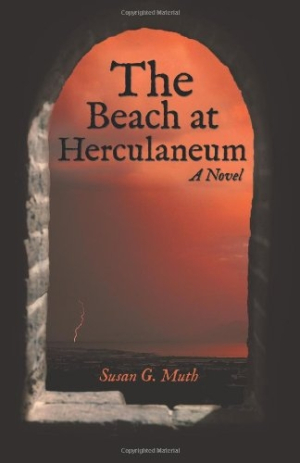The Beach at Herculaneum
Interweaving ancient and contemporary events through the lives of two women in The Beach at Herculaneum, first-time novelist Susan G. Muth takes a page or two from Anya Seton’s Green Darkness and Daphne du Maurier’s The House on the Strand.
Anne McCarthy’s life was shattered twice. Her family died in a sailing accident when she was an adolescent; years later, her husband and son died from car accident injuries. The grief she feels pushes her Roman Catholic faith near to its breaking point. On her confessor’s advice, she embarks upon a retreat at a Benedictine convent. Anne feels so peaceful there, she thinks she’s being called by God to become a nun. But the Mother Superior insists that Anne take a break from convent life, to allow her to determine if becoming a nun is not just a way of hiding from the world.
Strange dreams plague Anne during her convent stay, drawing her to the ancient Roman town of Herculaneum which, along with Pompeii, disappeared under the massive eruption of Mount Vesuvius in AD 79. She meets Mike DeMarco there, an archaeologist participating in a new dig in Herculaneum. Although she doesn’t know how it happened, Anne feels a strong paranormal connection to Daphne, a woman who lived in ancient Herculaneum and, along with her husband and son, perished in the volcano’s eruption. The parallels between their lives become clearer as Anne’s dreams become more frequent. Each woman is traveling toward her own kind of freedom which neither of them expected.
Muth’s arts background (as stage director, drama coach, painter and writer) serves her well; The Beach at Herculaneum moves effortlessly between the present and AD 79. The journeys Anne and Daphne make toward each other are artfully paralleled but never exactly copied, which adds depth and resonance to their individual stories. The interludes connecting most of the chapters to each other are otherworldly without being melodramatic, elegantly signalling the directions the novel will take.
Throughout this novel, the dialog between characters (and Anne’s internal dialogs) sounds natural and unforced. The exchange between Anne and Mike about their feelings for each other (p. 127) glows with an aching clarity:
He dropped his dish towel and came over to me. His eyes locked on mine. “Don’t you know how it is with me?”
I felt my heart racing, the beginnings of panic. He was too real, too physical, too close! “Mike,” I told him, “I’m not ready.”
His gaze was steady now. “I know. But there it is anyway.”
The themes of loss, isolation, and uncontrollable events are smoothly woven through this novel. A main character with well-grounded religious beliefs might seem to be at odds with a story that contains some offensive language and a few intimate scenes, but Muth has drawn Anne’s character as a passionate and intelligent woman. Her faith is in no way belittled or shoved aside.
If one condensed The Beach at Herculaneum into a Hollywood-style pitch, it might describe this novel as “romance meets history meets spirituality with a touch of the paranormal.” Muth delivers a novel that seamlessly connects those elements with firm control, plain yet deeply affecting prose, and the vision required to get from beginning to end with all the plot strands woven together, resulting in a very satisfying reading experience.
Reviewed by
J. G. Stinson
Disclosure: This article is not an endorsement, but a review. The publisher of this book provided free copies of the book and paid a small fee to have their book reviewed by a professional reviewer. Foreword Reviews and Clarion Reviews make no guarantee that the publisher will receive a positive review. Foreword Magazine, Inc. is disclosing this in accordance with the Federal Trade Commission’s 16 CFR, Part 255.

